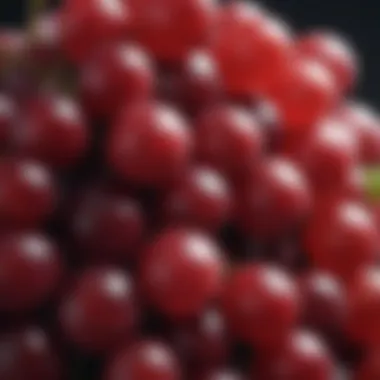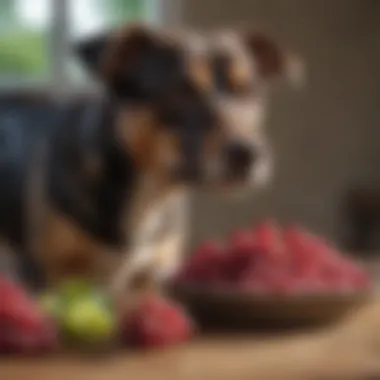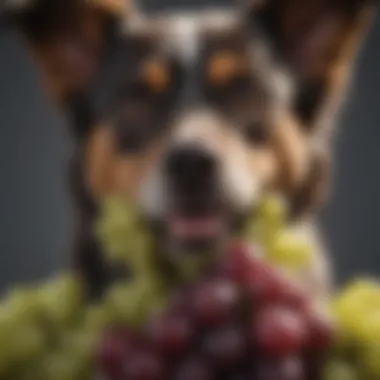The Dangerous Link Between Red Grapes and Canine Health


Intro
The discussion surrounding the consumption of red grapes by dogs is critical for pet owners. Many might not recognize the potential dangers these common fruits pose to canine health. Comprehensive understanding is necessary not just for awareness but also to promote informed decision-making among families and veterinarians alike. This article investigates the intricate relationship between red grapes and dogs, highlighting the key points that every pet owner ought to consider.
Fascinating Facts About the Animal
Unique Characteristics
Dogs possess a remarkable variety of traits that set them apart from other animals. They have acute senses, especially in smell, which is significantly more developed compared to humans. A dog's nose contains approximately 300 million olfactory receptors, allowing them to detect scents at incredibly low concentrations. Additionally, dogs exhibit a variety of coat colors, sizes, and temperaments, influenced by their breed and environment.
Extraordinary Abilities
Moreover, dogs are known for their loyalty and companionship. Many studies suggest that dogs can understand human emotions and respond accordingly. This emotional intelligence makes them exceptional service animals, aiding individuals with disabilities and assisting in therapeutic settings. Their trainability and diverse skills have resulted in their use in various roles, from search-and-rescue operations to therapy dog initiatives.
Health Implications of Red Grapes on Dogs
Understanding the toxicity of red grapes for dogs is paramount. A significant area of concerns is the kidney toxicity observed in dogs after ingesting grapes. While the exact mechanism remains undetermined, even small amounts can lead to severe health conditions.
Important Note: Not all dogs exhibit the same level of sensitivity, making it challenging to ascertain a safe quantity.
Behavioral Response to Dietary Changes
When faced with unwanted foods like red grapes, observed dog behaviors can be varied. Some dogs may refuse them outright due to their natural instincts while others might not recognize the danger. The variation in reactions emphasizes the need for vigilant monitoring by pet owners during feeding times. It is crucial to educate families on establishing a healthy diet that excludes toxic foods, ensuring the safety and well-being of their pets.
Summary
Intro to Dog Nutrition
Dog nutrition is a foundational topic for pet owners, veterinarians, and wildlife biologists alike. A proper diet plays an essential role in the overall health and well-being of dogs. Understanding what constitutes a balanced diet helps in making informed choices for canine health. Many factors influence a dog's nutritional needs, including age, breed, size, and lifestyle. This article will delve into the consequences of dietary choices, like the consumption of red grapes, to take a closer look at implications for pet care.
Importance of Canine Diet
A well-planned canine diet is vital for several reasons. First, nutrition impacts a dog's immune system, energy levels, and ability to maintain a healthy weight. Approximately 50% of dogs face obesity due to poor diet choices. A balanced diet helps prevent obesity and related health issues, such as diabetes and heart disease.
Moreover, proper nutrition influences behavior and cognitive function in dogs. Dogs receiving appropriate nutrients tend to be more alert and engage in more effective training. A deficient diet can lead to lethargy and lack of motivation, affecting their relationship with owners and the surrounding environment.
Finally, choosing quality food strengthens the human-animal bond. Owners who prioritize their dog's nutrition often feel more connected to their pets, leading to a fulfilling companionship. The key lies in understanding what makes up a well-rounded diet, and how specific foods, like red grapes, fit into that narrative.
Common Foods for Dogs
Dogs are omnivores, which means they can eat a variety of foods. Common dog food ingredients include:
- Meat: Chicken, beef, lamb, and fish are often considered staples. They provide essential proteins and fatty acids.
- Vegetables: Carrots, green beans, and sweet potatoes are common additions, offering vitamins and fiber.
- Grains: Rice and oats are frequent sources of carbohydrates. However, not all grains may be suitable for every dog.
- Fruits: Apples and blueberries are safe options, supplying natural sugars and antioxidants.
Unlike these typical foods, red grapes are widely regarded as hazardous for dogs. Recognizing this difference underscores the importance of comprehensive knowledge about canine nutrition. While many foods are beneficial, understanding the specific compounds in grapes that induce toxicity will be discussed in-depth in following sections. The goal is to empower pet owners with knowledge so they can make the best possible choices for their dogs.
Overview of Red Grapes
Understanding red grapes involves examining their complex nutritional profile and their health benefits for humans as well. Grapes are often celebrated for their antioxidants, vitamins, and other compounds that contribute to a healthy diet. However, the implications of consuming grapes extend beyond human nutrition. For pet owners, especially those with dogs, awareness about the relationship between red grapes and canine health is crucial.
Nutritional Profile
Red grapes boast a series of nutrients that are beneficial for humans. They are rich in vitamins C and K, as well as antioxidants like resveratrol and flavonoids. Resveratrol, in particular, is known for its anti-inflammatory properties. The fiber content in grapes supports digestive health. However, the significance of these nutrients lies primarily in their effects on humans. Studies indicate that a diet inclusive of grapes can lower the risk of certain diseases such as heart disease and diabetes.
- Vitamins: Grapes contain vitamin C, an essential vitamin that supports the immune system and skin health.
- Antioxidants: Compounds like resveratrol are praised for their potential in reducing inflammation and promoting heart health.
- Fiber: Provides digestive benefits while helping stabilize blood sugar levels.
While these aspects may benefit humans, it is essential to note that these nutrients do not translate to safety for dogs.
Health Benefits for Humans
For humans, consuming red grapes offers multiple health benefits, which have been validated through various scientific studies. The antioxidants help combat oxidative stress in the body, leading to improved overall health. Additionally, the consumption of red grapes has been associated with better cardiovascular health, as the flavonoids in grapes may aid in lowering blood pressure and improving cholesterol levels. It is also believed that these fruits can help with cognitive functions, delaying age-related decline.


"Studies have shown that regular consumption of grapes can lead to a healthier heart and a better functioning brain."
Furthermore, the hydration benefits of grapes should not be overlooked. Their high water content contributes to overall fluid intake, promoting hydration. However, it's important to be vigilant about portion sizes, as grapes contain sugars that can add extra calories to one’s diet. While they are a nutritious snack, moderation is key.
Grapes are a staple in many households, yet pet owners must exercise caution regarding their dogs. The discussion about the risks posed by grapes emphasizes the need for a deeper understanding of what appears to be a harmless fruit. The next sections will delve further into the implications of grapes in a dog's diet.
Canine Response to Grapes
The topic of canine response to grapes is crucial for many dog owners. Understanding how dogs react to grapes helps in recognizing the potential dangers associated with their consumption. This knowledge can also aid pet owners in making informed decisions to ensure their dog's health and safety.
Potential Toxicity
Several studies confirm that red grapes can be toxic to dogs. The exact mechanism isn’t fully understood, but it may involve specific compounds within the grapes. Even a small amount can cause distress in some dogs. The potential for toxicity is not just a myth; it is a verified risk that pet owners should take seriously.
Grapes can induce renal failure in dogs, leading to potentially life-threatening conditions. Pet owners should keep grapes far from their pets.
Symptoms of Grape Toxicity
Recognizing the symptoms of grape toxicity is essential for prompt treatment. Symptoms can emerge within hours to a few days after ingestion. Common signs that appear include:
- Vomiting
- Diarrhea
- Lethargy
- Loss of appetite
- Abdominal pain
If any of these symptoms occur after a dog consumes grapes, immediate veterinary attention is mandatory. Quick action can make a significant difference in outcomes.
Variability in Canine Reactions
Not every dog reacts to grapes the same way. Some dogs may eat grapes without apparent harm, while others may show severe reactions. Genetic and individual health factors likely contribute to this variability. It’s unclear why some dogs are more susceptible than others. Owners should be cautious and avoid taking any chances with grapes. Understanding these individual sensitivities is essential in preventing possible health risks. Regular consultations with a veterinarian can help to tailor safe dietary practices for each dog.
Research on Grapes and Dogs
The topic of grapes and dogs holds significant importance due to its implications on canine health. Research in this area is essential for understanding the risks involved, especially since certain foods can have dire effects on dogs. Grapes, specifically red grapes, have not only been a common fruit in human diets but have sparked concern among veterinarians and pet owners alike. It becomes relevant to investigate this matter deeply, looking into both scientific studies and the insights offered by veterinary professionals.
Scientific Studies Overview
Several scientific studies have been conducted to evaluate the potential toxicity of grapes in dogs. In particular, these studies focus on the varying responses that canines exhibit upon ingestion. Research has revealed a range of symptoms linked to grape consumption, including renal failure and other severe health complications. Importantly, studies indicate that not all dogs respond the same way; some dogs consume grapes and exhibit no immediate adverse effects, while others show symptoms quickly.
Key findings from several studies include:
- Toxicity Variability: Some breeds appear more susceptible than others, suggesting a genetic component to grap toxicity.
- Dosage Levels: Certain amounts of grapes can trigger a reaction in sensitive dogs; however, researchers are still uncertain about the exact toxic dose that leads to renal issues.
- Potential Compounds: Various compounds in grapes may trigger toxicity, but no specific toxin has been definitively identified. Ongoing research continues to explore this.
This body of evidence establishes a framework for ongoing discussions regarding pet health and nutrition, emphasizing the need for caution when considering our pets’ diets.
Veterinary Insights
Veterinary professionals often encounter cases related to grape consumption, leading them to provide invaluable insights regarding its effects on dogs. They stress that pet owners remain vigilant about the foods they offer their dogs, specifically avoiding grapes entirely.
Veterinarians often highlight these essential points:
- Immediate Action: If a dog ingests grapes, it is crucial to seek veterinary help immediately, even if symptoms are not yet visible.
- Continuous Monitoring Needed: Symptoms can appear hours or days post-consumption, making monitoring for changes in behavior or health essential.
- Educating Pet Owners: Many veterinarians spend considerable time educating pet owners about toxic foods, including grapes, emphasizing the importance of preventive measures.
Veterinarians agree that while some dogs show resilience, the uncertainty surrounding grapes’ effects on dog health warrants a preventive approach.
The combined efforts of scientific research and veterinary knowledge are critical in protecting canine health and fostering safe dietary habits among dog owners. As research evolves, so does our understanding of the complexities involved in feeding dogs even seemingly harmless foods like grapes.
Understanding Grape Toxicity Mechanisms
Understanding how red grapes can affect dogs is crucial for pet owners and veterinary professionals alike. The mechanisms of grape toxicity reveal why even a small amount can be harmful. This section focuses on the biological pathways and the impact on renal function, both essential in comprehending the risks associated with grape consumption.
Metabolic Pathways in Dogs
Grapes contain compounds that can be toxic to dogs, though the exact toxic agent remains unidentified. When ingested, substances in grapes are metabolized differently than in humans. It's important to analyze how these metabolic pathways may lead to adverse effects in dogs.


Research indicates that grape consumption can lead to increased levels of certain metabolites in a dog's system. These compounds may trigger oxidative stress, causing cellular damage. This damage can be particularly harmful to the kidneys, which handle the filtration of harmful substances from the blood.
Pet owners should be aware of how unique a dog's metabolism can be. Unlike human beings, dogs process food and its components differently, leading to distinct health outcomes after ingestion.
Impact on Renal Function
The kidneys play a vital role in filtering waste and balancing bodily fluids. Grape toxicity can significantly impair renal function in dogs. Studies show that grape ingestion can lead to acute kidney injury, a serious condition that poses risks to a dog's health.
Symptoms of kidney issues often start within 24 hours of ingesting grapes. Some common indicators include
- Vomiting
- Diarrhea
- Lethargy
- Decreased appetite
- Increased thirst and urination
If you notice these signs, take your pet to a veterinarian immediately.
Research on renal function indicates that the kidneys may become unable to perform their functions efficiently after exposure to grape components. This results in a cascade of metabolic disturbances that can be life-threatening if not addressed promptly. Understanding the impact on renal function emphasizes the necessity for vigilance regarding what dogs consume.
"The kidneys are fundamental to a dog's health. Recognizing the effects of specific foods, such as grapes, is paramount for their wellbeing."
Recommendations for Pet Owners
The topic of red grapes and their potential toxicity towards dogs is vital for responsible pet ownership. Understanding the implications of feeding grapes to dogs can ensure the health and safety of pets. Although grapes may be nutritious for humans, they pose serious risks for dogs. This section will address safe food practices and outline how to monitor canine diets effectively.
Safe Foods for Dogs
When considering a balanced diet for dogs, it is paramount to recognize safe alternatives to potentially harmful foods like grapes. Here are some safe food options to consider:
- Carrots: These crunchy vegetables are low in calories and high in vitamins.
- Apples: Remove seeds and core before feeding. Apples provide fiber and vitamins A and C.
- Blueberries: These small fruits are packed with antioxidants. They make a perfect training treat.
- Bananas: In moderation, bananas are safe and provide essential potassium.
It is important to note that not all fruits and vegetables are suitable for dogs. Pet owners should research or consult with a veterinarian before introducing new food items.
Monitoring Canine Diet
Monitoring a dog’s diet requires diligence. Owners should pay attention to what their dogs consume daily. This monitoring should include:
- Reading Labels: Carefully check ingredients in commercial pet foods. Avoid artificial additives and ingredients that may be harmful.
- Tracking Treats: Keep a list of treats given. Limit the quantity and ensure they come from safe sources.
- Observing Reactions: After introducing any new food, observe for any signs of allergies or toxicity. Symptoms can include vomiting, diarrhea, or signs of discomfort.
Regular consultations with a veterinarian can provide additional insight into an ideal diet tailored specifically for a dog’s breed, age, and health status.
Important Note: If a dog accidentally consumes grapes, immediate veterinary attention is necessary, regardless of observed symptoms.
By prioritizing safe foods and diligent diet monitoring, pet owners can safeguard their canine companions from potential hazards associated with inappropriate dietary choices.
Alternatives to Grapes
In the context of canine nutrition, it is vital to explore safe and healthy alternatives to grapes. Given the profound health risks associated with grape consumption, finding suitable fruits and treats for dogs is essential. This section aims to address specific elements regarding viable alternatives, their benefits, and important considerations for pet owners.
Safe Fruits for Dogs
Fruits can be a great addition to a dog's diet as they offer essential vitamins and fiber. However, choosing the right type of fruit is crucial. There are many fruits that dogs can safely consume without risk of toxicity. Some of these include:
- Apples: A good source of vitamins A and C. Make sure to remove the seeds and core.
- Blueberries: These are packed with antioxidants and are low in calories.
- Bananas: Rich in potassium and also a handy treat for dogs, but should be given in moderation due to high sugar content.
- Watermelon: Hydrating and low in calories, this fruit can be a refreshing snack for dogs on warm days. Always remove seeds and rind.
It is important to introduce any new fruit gradually into a dog's diet and observe for any adverse reactions. Each dog is unique, and what suits one may not suit another.
Healthy Treat Options
Apart from fruits, there are various healthy treat options that can enrich a dog's diet. Choosing snacks that are nutritious and devoid of harmful ingredients is essential. Here are some recommendations:
- Carrots: Crunchy and low in calories, carrots are good for dental health and provide vitamins.
- Pumpkin: This is high in fiber and can aid in digestion. Canned, plain pumpkin without additives is a good option.
- Sweet Potatoes: Rich in vitamins and minerals, they can be cooked and given in moderation as a treat.
- Peanut Butter: Ensure it is xylitol-free. Dogs often enjoy this spread as a flavorful treat, and it can also be used in toys for enrichment.
Each of these alternatives can serve as a safe option to introduce variety into a dog’s diet while avoiding grapes. Pet owners should always consult with a veterinarian before making significant changes to their dog's diet, especially if the dog has a history of dietary sensitivities.


It is essential to note that not all fruits and vegetables are safe for dogs. Awareness of potentially harmful foods is necessary to maintain the health and well-being of your pet.
Addressing Common Misconceptions
Addressing common misconceptions about red grapes and dogs is crucial for pet owners. Understanding what is true versus what is not can help in making informed decisions regarding canine health. Misunderstandings may lead to harmful practices or unjustified fears. Clear information can foster responsible pet ownership while contributing to the well-being of dogs.
Grapes Are Always Dangerous
The belief that all grapes pose a serious threat to dogs is widespread. However, while many dogs do have toxic reactions to grapes, not every dog will experience adverse effects. Several factors influence how a dog may react to grapes.
Some breeds may be more susceptible to the toxic effects than others. For instance, certain small breeds may exhibit more extreme reactions than larger ones. Age and health status can also be important. Young, healthy dogs may process substances differently than older or ill dogs. This variability means not every dog will react to grapes in the same way.
To clarify, the toxic compound in grapes is not yet identified. Some dogs may consume a small amount without any immediate negative consequence. However, the risks associated with grape consumption remain significant enough that many veterinarians recommend avoiding grapes altogether.
It is essential to remember that just because some dogs can eat grapes without visible harm, it does not mean grapes are safe.
Understanding Individual Sensitivities
Individual sensitivities to grapes highlight the complexity of canine reactions. The genetic makeup of a dog plays a significant role in how it processes various substances. Some dogs may metabolize certain compounds in grapes effectively, while others may suffer serious reactions.
Examples of individual sensitivities include:
- Size of the Dog: Smaller dogs may have fewer acceptable limits than larger breeds.
- Age: Puppies and older dogs may react differently than young adults.
- Existing Health Conditions: A dog with pre-existing kidney issues may have a higher risk when consuming grapes.
Pet owners should closely monitor their dogs for any signs of distress after potential exposure to grapes. Understanding that reactions are not the same for every dog can help in making better dietary choices.
Legal and Ethical Considerations
The topic of legal and ethical considerations surrounding the feeding of red grapes to dogs is essential for both pet owners and professionals alike. This section highlights various aspects that reflect on the responsibilities of pet guardians and the legal frameworks aimed at ensuring pet safety. Understanding this part of responsibility is vital, especially given the potential health risks involved in feeding grapes to canines. Concern over their impact requires careful regulation and informed choices in pet care.
Regulations on Pet Food Safety
In recent years, various regulations on pet food safety have emerged. Regulatory agencies are focused on protecting animal health. These organizations ensure that pet food products meet specific safety standards, which include ingredients being non-toxic. In many countries, there are guidelines that restrict the use of harmful substances in commercial dog food. However, as red grapes are not a traditional pet food ingredient, they often fall outside strict regulatory scrutiny. Thus, the responsibility often leans heavily on pet owners.
Pet food safety regulations may include:
- Ingredient transparency: Manufacturers must disclose the contents of their products, allowing responsible choices.
- Safety testing: Many dog food products undergo testing for harmful ingredients.
- Recalls: If certain products are found to be unsafe, regulations ensure that they are recalled promptly to protect pets from harm.
However, the absence of regulations regarding specific non-food items, like grapes, may lead to unforeseen consequences for pets. Thus, owners must exercise caution and stay informed.
Responsibility of Pet Owners
Pet owners hold a crucial responsibility in safeguarding their dogs' health. Awareness and knowledge about which foods are safe or harmful is a significant part of this duty. Owners should prioritize preventing toxic exposure to their pets. Information from veterinarians and credible sources can guide pet owners in making the best dietary choices.
Key responsibilities include:
- Educating themselves: Owners should learn about harmful foods, including grapes that may have toxic effects.
- Monitoring their dog's diet: Keeping track of what dogs consume helps prevent inadvertent grape ingestion.
- Consulting with professionals: Regular communication with veterinarians ensures that dog owners are aware of the changing knowledge regarding food safety.
Closure
The topic of grape consumption in dogs is significant for several reasons. Understanding the possible health risks associated with red grapes can help protect the well-being of canine companions. The information presented in this article synthesizes research findings and veterinary observations, which highlight the toxic nature of grapes to some dogs. This effect is not universal, yet the unpredictability adds a layer of concern for pet parents. It reveals the necessity for vigilance in dietary choices for dogs.
Summary of Findings
In summary, the potential toxicity of red grapes in dogs is a critical concern. Key points from this article include:
- Grape toxicity varies among individual dogs, leading to different reactions to similar amounts of grapes.
- Symptoms of toxicity may present as gastrointestinal upset, lethargy, or more severe renal impairment.
- Continuing research underscores the complexities surrounding the passive and active ingredients in grapes that may trigger adverse health effects.
- The regulatory environment regarding pet food and ingredients includes a growing awareness of such hazards.
These findings provide a substantial overview of why vigilance in managing canines' diets is essential for pet owners.
Final Recommendations
For dog owners, the implications of grape toxicity requires careful consideration. Here are several recommendations:
- Avoid Feeding Grapes: Refrain from giving red grapes or any grape products to dogs.
- Educate Family Members: Ensure everyone in the household understands the risks associated with grapes.
- Monitor for Symptoms: Maintain awareness of any unusual behavior in your dog after potential exposure to grapes.
- Consult a Veterinarian: In case of accidental consumption, seek immediate guidance from a veterinary professional.
By following these guidelines, pet owners can safeguard their dogs from the less understood risks of grapes and foster overall good health.







